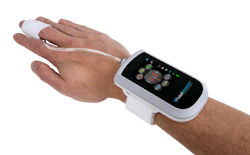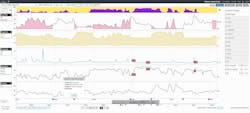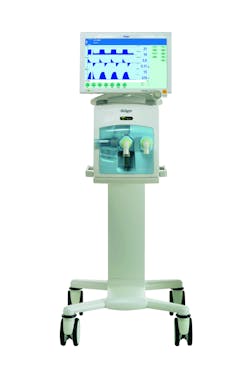Talent and technology must converge in respiratory care delivery
Breathing is essential to life, but most individuals take it for granted until they experience an issue.
In today’s world of contagious respiratory illnesses (RSV, flu, SARS-CoV2, pneumonia, bronchitis), common conditions such as asthma and chronic obstructive pulmonary disease (COPD), and the widespread use of oxygen therapy and mechanical ventilation for acute and non-acute care, it is likely most people will find themselves needing respiratory support at some point in their lives.
HPN asked respiratory care product and solutions manufacturers to share some of the latest high-tech options to assist clinicians in helping patients breathe and monitoring their respiratory status. Also presented are some of the ongoing challenges that continue to impact respiratory care delivery and monitoring success.
New technologies in respiratory care
Respiratory therapists (RT) are a vital but scarce resource in today’s healthcare environment. Recent research has found more than 92,000 RTs will leave the profession by 2030 while there is a need to retain more than 155,000 RTs.
Technology advancements, particularly those that make it easier and more efficient for RTs to care for patients, are essential in respiratory cate delivery. When asked for their biggest barriers to better patient care, “Technology availability/function/performance” was a close second to “Talent on our team/understaffed”, at 65% and 67% respectively. Among the RTs surveyed, 84% said they have influence in making decisions around patient care and technology.
Product and solutions providers are developing technologies to help RTs deliver safe and effective care in a more efficient manner given the significant staff shortages in the profession. Here are three such innovations.
Respiratory monitoring goes digital
The digital transformation of healthcare is frequently cited these days by leading analyst firms, industry thought leaders and futurists. For example, Deloitte stated in its 2023 Global Health Care Outlook report, “One of the silver linings of COVID-19 was that it accelerated advances in digitization and telemedicine that previously were hard to be accepted by either patients or clinicians.”
Johnny Mann, VP sales and marketing, Caretaker Medical, said the most promising digital healthcare trend in respiratory monitoring is the integration of wearable monitoring, wireless technology, and predictive analytic tools.
When describing wearable monitoring devices, Mann pointed to devices such as smartwatches or wearable sensors that continuously monitor and transmit vital signs, including heart rate, respiratory rate, and blood pressure, to healthcare providers.
Mann noted how wireless technology has enabled remote monitoring of patients, allowing healthcare providers to monitor patients from a distance and respond quickly if there are any changes in their condition.
Speaking about predictive analytics, Mann commented on how they are being used in patient monitoring to help healthcare providers detect changes in patients’ conditions more quickly and accurately. He provided the example of an Early Warning System (EWS), which can be used to analyze vital signs and other data to predict when a patient may be at risk of complications and provide insights needed to create personalized treatment plans.
“These three digital advances are expanding access to advanced care, automating routine tasks and streamlining the workload of nurses, which can improve job satisfaction, reduce burnout, and improve patient outcomes,” said Mann. “At Caretaker Medical we are pioneering a digital health platform that delivers real-time comprehensive ICU-grade parameters never before available in one mobile device.”
Mann said Caretaker Medical’s flagship product, VitalStream, is the world’s only wireless wearable to be clinically validated and U.S. Food and Drug Administration (FDA) cleared to measure continuous blood pressure, cardiac output, and other hemodynamic parameters continuously, non-invasively, and wire-free.
VitalStream is designed to improve hospital patient care in several ways:
- Rapid assessment: The real-time continuous monitoring capabilities of VitalStream allow for rapid assessment of a patient's hemodynamic status, which can help healthcare providers quickly identify and respond to changes in the patient's condition.
- Early warning system: The VitalStream platform can act as an early warning system for health care providers by alerting them of any changes in a patient's vital signs that could indicate a problem. This can be especially useful for patients who are at high risk for complications, such as the elderly or those with chronic illnesses.
- Reduced need for manual checks: Continuous monitoring with VitalStream can reduce the need for manual checks, freeing up healthcare staff time for other tasks and improving the efficiency of care.
- Better decision-making: Real-time hemodynamic monitoring provides healthcare providers with accurate and up-to-date information about a patient’s status, which can help inform better clinical decisions and guide therapy.
- Reduced risk of overtreatment: With real-time monitoring, healthcare providers can avoid overtreating patients with unnecessary interventions, which can reduce the risk of harm.
“Overall, the VitalStream monitor can help healthcare providers provide more effective, efficient, and patient-centered care,” Mann added.
Increasing interest in AI
When asked which technologies are most likely to be implemented by 2025, 92% of healthcare chief information officers (CIO) surveyed by Gartner selected artificial intelligence (AI)/machine learning (ML).
“AI in healthcare has the potential to free up millions of hours, allowing healthcare professionals to meet more patients and commit more time to complex medical activities,” stated Danielle Rasooly and Muin J. Khoury, Office of Genomics and Precision Public Health, Centers for Disease Control and Prevention (CDC), in their article on AI in medicine and public health.
“Artificial intelligence (AI) has now penetrated many aspects of healthcare – although adoption is often lagging,” said Kathryn Clark, MS, RRT-NPS, Director of Clinical Development, Etiometry. “The lucky respiratory care teams who’ve already embraced it see how AI can enhance care and make their work more satisfying. I say ‘lucky’ because we know respiratory therapists are getting burned out with increased patient loads and needing to address more complex conditions. AI is poised to counter those stresses.”
“AI offers a way to make informed data-driven clinical decisions allowing for earlier liberation from mechanical ventilation,” Clark continued. “Critical care teams are focusing on intensive care unit (ICU) liberation and creating protocols to extubate patients as quickly and safely as possible to minimize potential adverse effects of invasive ICU interventions. This is a central reason clinicians look to Etiometry’s clinical decision support software, which uses over 150 million hours of deidentified patient data to inform its AI-based, FDA-cleared risk algorithms.”
Etiometry’s software platform allows respiratory therapists to monitor patient conditions at the bedside and remotely, as well as gain insight into patient deteriorations so clinicians can intervene more quickly. Developed in the ICU, the platform includes data aggregation and visualization with continuous display, risk-based analytics, protocol automation, and remote surveillance. Its customizable workflow automation alerts physicians, nurses and respiratory therapists when hospital-specific protocol conditions are met, such as eligibility for spontaneous breathing trial or extubation readiness.
“Etiometry’s market-leading clinical decision support software empowers care teams to make rapid, informed decisions that reduce ICU length of stay and associated costs,” Clark added.
Flexible ventilation support continuity of care
“Hospitals are faced with labor shortages and a steady flow of patients that require ICU care by a team of MDs, RNs, and RTs,” said Ed Coombs, MA, RRT-NPS, ACCS, FAARC, Sr. director of marketing at Dräger in North America. “This coupled with the financial pressures creates the need for identifying value and efficiency in the delivery of care. Trends in respiratory care are multi-faceted. Automation in monitoring workflow, including the avoidance of intubation and cost-effectiveness remain at the forefront.”
Coombs described how the Dräger Evita Infinity V500 ventilator takes a comprehensive approach to the continuity of care with the ability to provide high flow oxygen therapy, non-invasive ventilation in volume and pressure modes, as well as a full array of invasive modes of ventilation.
“The patient ranges of infant, pediatric, and adult allows for flexibility within the hospital to service all its ICUs within the facility,” said Coombs. “A pragmatic approach to automated weaning using SmartCare/PS has also led to decreased ventilation time and earlier discharge from the ICU.”
Ongoing issues impacting respiratory care
Respiratory care is complex and can be complicated by a variety of factors, both clinical and technical. Here are several long-standing challenges that continue to present issues in care delivery and monitoring.
Skin pigmentation and pulse oximetry
One respiratory monitoring issue that has been recently garnering national attention is how pulse oximetry can be less accurate for people who have dark skin pigmentation.
This is by no means a new subject in clinical research. A search of PubMed reveals research on the effect of skin pigmentation on pulse oximetry accuracy dating back nearly four decades, with a study by JR Emery, Department of Pediatrics, Riverside General Hospital, Loma Linda University Medical Center, published in the Fall 1987 Journal of Perinatology.
What has spurred a focus on the issue by the FDA, industry associations and the trade and mainstream media in more recent years is a 2020 study by researchers at the University of Michigan Hospital in Ann Arbor, MI that found “Black patients had nearly three times the frequency of occult hypoxemia that was not detected by pulse oximetry as White patients.”
These findings have since prompted additional research on the disparities in hypoxemia detection via pulse oximetry, and the formation of an FDA committee to “discuss the concerns related to pulse oximeters being less accurate in individuals with darker skin pigmentations.”
Ventilator cleaning and disinfection
According to the Agency for Healthcare Research and Quality (AHRQ), 800,000 patients receive mechanical ventilation in the U.S. each year. While it is a common intervention, there are challenges to its safe administration, including the effective reprocessing of reusable ventilator components.
ECRI has named “Confusion Surrounding Ventilator Cleaning and Disinfection Requirements Can Lead to Cross- Contamination as one of its “Top 10 Health Technology Hazards for 2023,” stating how “Reprocessing instructions provided by ventilator manufacturers are, in some cases, incomplete or confusing; and even guidance from regulatory authorities is not always clear.”
In its report, ECRI stated:
“Lack of clarity about the cleaning and disinfecting steps to be taken between patients can lead to ineffective reprocessing of ventilator components. This in turn increases the risk of cross- contamination, an otherwise preventable occurrence that can lead to the spread of infectious disease.”
To help address the issue, “ECRI challenges manufacturers to ensure that their instructions for cleaning and disinfecting ventilator components are complete, clear, well documented, and realistically achievable. The instructions should specify the frequency of cleaning and/or disinfection for all essential ventilator components.”
Ventilator associated pneumonia
“Historically, ventilator-associated pneumonia, or VAP, was considered one of the most lethal healthcare-associated infections (HAI),” stated AHRQ in its Monitoring Ventilator-Associated Events Facilitator Guide. While much work has been done to reduce VAP rates in the U.S., the COVID-19 pandemic served to drive it up.
A Centers for Disease Control and Prevention (CDC) analysis published in Infection Control & Hospital Epidemiology found ventilator-associated events (VAEs) had the largest increase across all HAI types from 2019 to 2021. “First quarter standardized infection ratios (SIRs) were 51% higher than the same period in 2019, and 60% higher in the third quarter when the Delta variant drove COVID-19-related hospitalizations to all-time highs.”
In 2022, Infection Control & Hospital Epidemiology published updated guidance, Strategies to prevent ventilator-associated pneumonia, ventilator-associated events, and nonventilator hospital-acquired pneumonia in acute-care hospitals, which was sponsored by the Society for Healthcare Epidemiology (SHEA).
Nuisance alarms
Alarm management continues to top patient safety priority lists from leading healthcare standards bodies and policy makers. “Reduce patient harm associated with clinical alarm systems” is one of The Joint Commission’s (TJC) 2023 National Patient Safety Goals (NPSG) for hospitals (NPSG.06.01.01), with the recommendation being to “improve the safety of clinical alarm systems.”
One recent study of patient monitor alarms in a university hospital emergency department found the most common alarm types to be respiratory related: respiratory rate high (32.2%), pulse oximetry low (16.2%) and pulse oximetry probe off (14.3%).
When Avera Heart Hospital in Sioux Falls, S.D. was developing a NPSG-compliant clinical alarm management system with Dräger, they discovered their baseline alarm count for three critical care and telemetry patient units was 18,798 alarms in a week – which averaged 71 alarms per patient, per day. The biggest alarm source was advisory alarms specific to SpO2 – which accounted for 46% of the alarms.
Based on this information, Dräger and Avera reviewed default settings and eliminated duplicate and non-actionable alarms – such as couplets, bigeminy, bradycardia and tachycardia – and replaced them with high/low parameters.
Premature ventricular complexes (PVC) parameters were changed from 10 to 20/min. SpO2 was decreased to 88%. Retraining was done on proper skin hygiene prior to lead placement and uses of oximetry technology.
After the initial changes, Avera was able to reduce the average per bed/per day alarm count from 71 to 42 – a reduction of 30%.
The future of respiratory care
Respiratory care is a vital, dynamic discipline that continues to advance in professional growth and technological innovation despite challenges in its path.
In its 2022 review, the National Board for Respiratory Care (NBRC) noted how it had administered 22,626 examinations last year, a slight increase over 2021 (22,443 exams). They also awarded 12,471 new credentials. Exams and credentials spanned specialty areas such as sleep disorders, adult critical care, neonatal/pediatrics, asthma, clinical simulation, and pulmonary function technology.
With regards to technology, RTs say the top three procedures needing innovation are mechanical ventilation, secretion management and aerosol therapy, while the top three technologies needing innovation are ventilators, nebulizers and oxygen blenders, according to a survey conducted by the American Association for Respiratory Care (AARC) and Boston Scientific.
The convergence of talent and technology to support the future of respiratory care was cited by Dräger’s Coombs in a recent article on the RT shortage:
“I call on all stakeholders to the respiratory care profession to do more in support of RTs on the front lines today, while making improvements so that the future generation sees the profession not as a burden but as an opportunity for personal and professional greatness.”
References
1. Why We Need More RTs – and How to Help, https://www.morerts.com/growing-need/
2. The State of Respiratory Therapy: A 2021-2022 Report, https://www.aarc.org/wp-content/uploads/2021/09/the-state-of-respiratory-therapy.pdf
3. 2023 Global Health Care Outlook, Deloitte, https://www.deloitte.com/content/dam/assets-shared/legacy/docs/gx-health-care-outlook-2023-digital-transformation.pdf
4. 2023 CIO Agenda Insights for Healthcare Providers, Gartner, https://emtemp.gcom.cloud/ngw/globalassets/en/information-technology/documents/2023-cio-agenda-healthcare-providers-infographic.pdf
5. Artificial Intelligence in Medicine and Public Health: Prospects and Challenges Beyond the Pandemic, CDC, March 1, 2022, https://blogs.cdc.gov/genomics/2022/03/01/artificial-intelligence-2/
6. COVID-19 made pulse oximeters ubiquitous. Engineers are fixing their racial bias, NPR, February 13, 2023, https://www.npr.org/2023/02/10/1156166554/covid-19-pulse-oximeters-racial-bias
7. A growing push to fix pulse oximeters’ flawed readings in people of color: ‘This can be dangerous’, CNN Health, December 7, 2022, https://edition.cnn.com/2022/12/07/health/pulse-oximeters-inaccuracies
8. Emery JR. Skin pigmentation as an influence on the accuracy of pulse oximetry. J Perinatol. 1987 Fall;7(4):329-30. PMID: 2463349
9. Sjoding MW, Dickson RP, Iwashyna TJ, Gay SE, Valley TS. Racial Bias in Pulse Oximetry Measurement. N Engl J Med. 2020 Dec 17;383(25):2477-2478. doi: 10.1056/NEJMc2029240. Erratum in: N Engl J Med. 2021 Dec 23;385(26):2496. PMID: 33326721; PMCID: PMC7808260.
10. FDA Executive Summary, Review of Pulse Oximeters and Factors that can Impact their Accuracy, https://www.fda.gov/media/162709/download
11. Overview: Getting Patients Off the Ventilator Faster: Facilitator Guide, AHRQ, https://www.ahrq.gov/hai/tools/mvp/modules/vae/overview-off-ventilator-fac-guide.html#:~:text=Here%20are%20some%20background%20statistics%20regarding%20mechanical%20ventilation%3A,percent%20of%20mechanically%20ventilated%20patients%20develop%20a%20VAE
12. Top 10 Health Technology Hazards for 2023, ECRI, https://www.ecri.org/top-10-health-technology-hazards-2023-executive-brief
13. Monitoring Ventilator-Associated Events: Facilitator Guide, AHRQ, https://www.ahrq.gov/hai/tools/mvp/modules/vae/monitoring-fac-guide.html
14. COVID-19 Impact on HAIs, CDC, https://www.cdc.gov/hai/data/portal/covid-impact-hai.html
15. Klompas, M., Branson, R., Cawcutt, K., Crist, M., Eichenwald, E., Greene, L., . . . Berenholtz, S. (2022). Strategies to prevent ventilator-associated pneumonia, ventilator-associated events, and nonventilator hospital-acquired pneumonia in acute-care hospitals: 2022 Update. Infection Control & Hospital Epidemiology, 43(6), 687-713. doi:10.1017/ice.2022.88
16. National Patient Safety Goals, Effective January 2023 for the Hospital Program, The Joint Commission, https://www.jointcommission.org/-/media/tjc/documents/standards/national-patient-safety-goals/2023/npsg_chapter_hap_jan2023.pdf
17. Jämsä JO, Uutela KH, Tapper AM, Lehtonen L. Clinical alarms and alarm fatigue in a University Hospital Emergency Department-A retrospective data analysis. Acta Anaesthesiol Scand. 2021 Aug;65(7):979-985. doi: 10.1111/aas.13824. Epub 2021 May 4. PMID: 33786815
18. 2022 Examinations in Review, NBRC, https://www.nbrc.org/wp-content/uploads/2023/02/2022-Exams-in-Review-Info-Sheet.pdf
19. The State of Respiratory Therapy: A 2021–2022 Report, AARC, https://www.aarc.org/wp-content/uploads/2021/09/the-state-of-respiratory-therapy.pdf
20. The Respiratory Therapist Shortage: Why We Must Invest In RTs today, Dräger, https://www.draeger.com/en-us_us/Hospital/Insights/Enhancing-Patient-Experience/Respiratory-Therapist-Shortage
About the Author
Kara Nadeau
Senior Contributing Editor
Kara Nadeau is Sterile Processing Editor for Healthcare Purchasing News.




